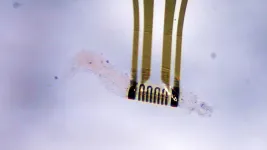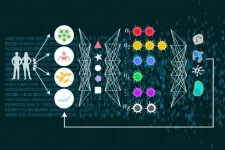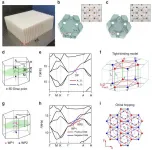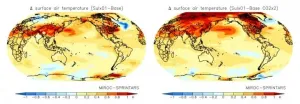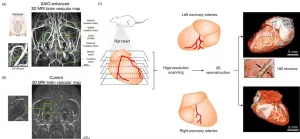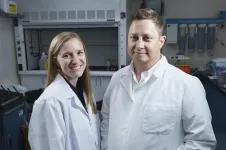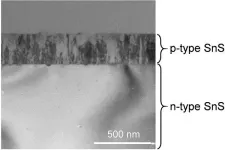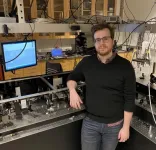(Press-News.org) Flexible and adaptive microelectronics is considered an innovation driver for new and more effective biomedical applications. These include, for example, the treatment of damaged nerve bundles, chronic pain, or the control of artificial limbs. For this to work, close contact between electronics and neural tissue is essential for effective electrical and mechanical coupling. In addition, potential applications arise from the production of tiny and flexible surgical tools.
An international team led by Prof. Dr. Oliver G. Schmidt, head of the Institute for Integrative Nanosciences at the Leibniz Institute for Solid State and Materials Research (IFW) Dresden and holder of the Professorship of Materials for Nanoelectronics at Chemnitz University of Technology and initiator of the Center for Materials, Architectures and Integration of Nanomembranes (MAIN), as well as Boris Rivkin, a PhD student in Prof. Schmidt's group, has now demonstrated for the first time that such adaptive microelectronics are able to position themselves in a controlled manner, manipulate biological tissue, and respond to their environment by analyzing sensor signals. The results, with Rivkin as first author, have appeared in the journal "Advanced Intelligent Systems".
Different properties for dynamic processes combined for the first time in adaptive microelectronics
Until now, it has not been possible for microelectronic structures to both sense and adapt to their environment. Although there are structures with a strain sensor that monitor their own shape, microelectronics with magnetic sensors that orient themselves in space, or devices whose motion can be controlled by electroactive polymer structures, a combination of these properties for application in a dynamic changing organism at the micrometer scale, i.e. well below a millimeter, has not been reported so far.
Adaptive and intelligent microelectronics
At the heart of these applications is a polymer film, just 0.5 mm wide and 0.35 mm long, which acts as a carrier for the microelectronic components. By comparison, a 1-cent piece has a diameter of around 16 mm. In their publication, the team from Chemnitz University of Technology and the Leibniz IFW in Dresden now presents adaptive and intelligent microelectronics that use microscopic artificial muscles to reshape and adapt to dynamic environments thanks to the feedback of appropriate sensors.
The sensor signals are fed through electrical connections to a microcontroller, where they are evaluated and used to generate control signals for the artificial muscles. This allows these miniature tools to adapt to complex and unpredictable anatomical shapes. For example, nerve bundles have always different sizes. Adaptive microelectronics can gently enclose these nerve bundles to establish a suitable bioneural interface.
Essential for this is the integration of shape or position sensors in combination with microactuators. Adaptive microelectronics are therefore manufactured in a so-called "monolithic wafer-scale process." "Wafers" are flat substrates made of silicon or glass on which the circuits are manufactured. Monolithic production allows many components to be manufactured simultaneously in parallel on one substrate. This enables fast and at the same time more cost-effective production.
Artificial muscles generate movement - use in organic environment possible
The movement and reshaping of adaptive microelectronics is achieved by means of artificial muscles, the so-called "actuators". These generate movement by ejecting or absorbing ions and can thus reshape the polymer film.
This process is based on the use of the polymer polypyrrole (PPy). The advantage of this method is that manipulation of the shape can be carried out in a targeted manner and with already very low electrical bias (less than one volt). The fact that artificial muscles are also safe for use in organic environments has already been demonstrated by other groups in the past. This involved testing the performance of the micromachines in various environments relevant to medical applications, including cerebrospinal fluid, blood, plasma, and urine.
Going for even more complex microelectronic robots in the future
The team from Dresden and Chemnitz expects that adaptive and intelligent microelectronics will be developed into complex robotic microsystems in the medium term. Boris Rivkin says: "The crucial next step is the transition from the previously flat architecture to three-dimensional micro-robots. Previous work has demonstrated how flat polymer films can reshape into three-dimensional structures through self-organized folding or rolling. We will add adaptive electronics to such materials to develop systems such as robotic micro-catheters, tiny robotic arms, and malleable neural implants that act semi-autonomously following a digital instruction."
Dr. Daniil Karnaushenko, group leader in Prof. Oliver Schmidt's team, adds, "Such complex microrobots will require a large number of individual actuators and sensors. To effectively accommodate and use electronic components in such a density is a challenge because more electrical connections are needed than space is available. This will be solved by complex electronic circuits that will be integrated into adaptive microelectronics in the future to pass the appropriate instructions through to the right components."
This work also contributes to the emerging field of robot-assisted surgery, which could enable less invasive yet more precise procedures. Smart surgical tools that generate reliable feedback about their shape and position could become indispensable in treating delicate tissue.
INFORMATION:
About team leader Prof. Dr. Oliver G. Schmidt
Oliver G. Schmidt was appointed Chair of the Professorship of Materials for Nanoelectronics at Chemnitz University of Technology in 2007 and is also Director of the Institute for Integrative Nanosciences at the Leibniz Institute for Solid State and Materials Research (IFW) Dresden.
Schmidt is a pioneer in the field of microrobotics and micromotors. He and his research team's work in nanoscience bridges disciplines in physics, chemistry, materials science, electronics, and microsystems engineering. Schmidt has demonstrated the application potential of his scientific findings in microrobotics, photonics, sensor technology, medicine, and energy storage in numerous research papers. In 2010, he and his former colleagues have built the smallest man-made jet propulsion system and in 2020, the smallest microelectronic robot.
In 2018, he was honored with the Gottfried Wilhelm Leibniz Prize - the most important research award in Germany - for his outstanding work on the research, production, and innovative application of functional nanostructures. Schmidt is a member of the German Academy of Science and Engineering (acatech) (German) and is one of the most highly cited scientists worldwide.
About Boris Rivkin
Boris Rivkin studied physics at the University of Heidelberg and has been working on his PhD as part of Prof. Dr. Oliver G. Schmidt's group since 2017. His research interests are in the field of flexible microsystems, and the shape control and integration with electronic functionalities thereof.
Tokyo, Japan - Scientists from the Institute of Industrial Science at The University of Tokyo demonstrated how the adaptive immune system uses a method similar to reinforcement learning to control the immune reaction to repeat infections. This work may lead to significant improvements in vaccine development and interventions to boost the immune system.
In the human body, the adaptive immune system fights germs by remembering previous infections so it can respond quickly if the same pathogens return. This complex process depends on the cooperation of many ...
Recently, the three-dimensional (3D) Dirac points and 3D Dirac semimetals have attracted tremendous attention in the field of topological physics. The 3D Dirac point is a fourfold band crossing in 3D momentum space, which can be view as the degeneracy of two opposite Weyl points. However, the 3D Dirac points can be described by the Z2 topological invariant other than the Chern number. The topological property of 3D Dirac point is not totally the same as Weyl point. Besides, the transition from Dirac points to Weyl points has not been experimentally studied in both photonic and acoustic systems so far. Therefore, the theoretical or experimental breakthrough of 3D Dirac points and the study on their transition is of great ...
As countries around the world race to mitigate global warming by limiting carbon dioxide emissions, an unlikely source could be making climate goals harder to achieve without even deeper cuts in greenhouse gas production: reductions in air pollution.
New modeling experiments from Kyushu University in Japan of the long-term effects of reductions in pollutants known as sulfate aerosols predicts further increases in surface air temperature at current and increased carbon dioxide levels because of the loss of an overall cooling effect caused by the light-scattering particles.
"Air pollution causes an estimated seven million premature deaths per year worldwide, so action is essential, especially in emerging and developing countries, which tend to be most affected," ...
Heart attack and stroke are the first and second leading causes of death in developed countries, respectively. As the disease often results in sudden death with few special prognostic symptoms, early diagnosis is very important. For this purpose, imaging techniques such as magnetic resonance imaging (MRI) are widely used to identify the narrowing or blockage of blood vessels.
In MRI, contrast agents improve the visibility of the structures such as smaller blood vessels within the body. Just as satellites or global positioning systems (GPS) give traffic congestion information, the MRI contrast agents can give accurate information of vascular conditions such as vascular ...
A year ago, infectious disease doctor Christine Johnston was leading a study on the use of hydroxychloroquine for the treatment of people with COVID-19.
The trial launched at the end of March, when the disease was putting the world on pause and killing thousands.
Hydroxychloroquine showed promise in studies done in test tubes rather than in animals or humans. If the drug worked, it would be cheap, safe, and available. As the trial got going in April, however, hydroxychloroquine was being touted as a treatment without any rigorous evidence.
"The world was at a desperate moment and people were jumping to conclusions," ...
During the height of the first COVID-19 lockdown in the UK, women spent more time on unpaid housework and childcare than men, were more likely to reduce working hours, and reported higher levels of psychological distress, according to a new study published last week in the open-access journal PLOS ONE by Baowen Xue and Anne McMunn of University College London, UK.
Before the COVID-19 pandemic, studies had already shown that women in the UK today spend more time doing unpaid care work than men. In March 2020, childcare facilities and schools in the UK were shut down in response ...
Young people at ultra-high risk of developing psychosis have significantly higher psychotic symptoms if they are an evening person, researchers at Orygen, Australia's centre of excellence in youth mental health, have found.
Their research, published last month in the journal Early Intervention in Psychiatry, investigated the link between sleep disturbance, chronotype - whether the young person was a morning or evening person - and psychotic symptoms.
Orygen's Dr Jessica Hartmann, who led the study, said the research involved clinical interviews and self-report ...
Psychedelic healing may sound like a fad from the Woodstock era, but it's a field of study that's gaining traction in the medical community as an effective treatment option for a growing number of mental health conditions.
While the study of psychedelics as medicine is inching toward the mainstream, it still remains somewhat controversial. Psychedelics have struggled to shake a "counterculture" perception that was born in the 1960s, a view that had stymied scientific study of them for more than 50 years.
But that perception is slowly changing.
Mounting research suggests ...
A team of researchers from Tohoku University have created a tin monosulfide (SnS) solar cell that boasts attractive performance levels, promoting affordable and clean energy and moving society closer to achieving the UN's sustainable development goals.
Their results were published in the journal Solar RRL on February 25, 2021.
Current thin film solar cells often use cadmium telluride and copper indium gallium selenide to induce the photovoltaic effect. However, these materials contain rare and toxic elements. In contrast, tin and sulfur are abundant, easy to refine and non-toxic.
The key to high efficiency SnS solar cells lies within the p-n homojunction. P-type SnS is easy to fabricate, but the same cannot be said of n-type SnS. The complexity of ...
Photosynthetic organisms harvest light from the sun to produce the energy they need to survive. A new paper published by University of Chicago researchers reveals their secret: exploiting quantum mechanics.
"Before this study, the scientific community saw quantum signatures generated in biological systems and asked the question, were these results just a consequence of biology being built from molecules, or did they have a purpose?" said Greg Engel, Professor of Chemistry and senior author on the study. "This is the first time we are seeing biology actively exploiting quantum effects."
The scientists studied a type of microorganism called green sulfur bacteria. These bacteria need light to survive, but even small amounts of oxygen can damage their delicate photosynthetic equipment. ...
